《植物化学保护》课程教学资源(英文讲稿)Pesticide Health Hazards - Exposure and Personal Protective Equipment
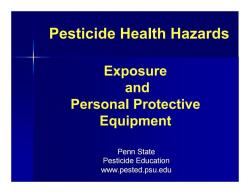
Pesticide Health Hazards Exposure and Personal Protective Equipment Penn State Pesticide Education www.pested.psu.edu
Exposure and Personal Protective Equipment Pesticide Health Hazards Penn State Penn State Pesticide Education Pesticide Education www.pested.psu.edu www.pested.psu.edu
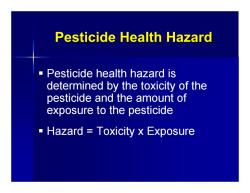
Pesticide Health Hazard Pesticide health hazard is determined by the toxicity of the pesticide and the amount of exposure to the pesticide Hazard Toxicity x Exposure
Pesticide Health Hazard Pesticide Health Hazard Pesticide health hazard is determined by the toxicity of the pesticide and the amount of exposure to the pesticide Hazard = Toxicity x Exposure
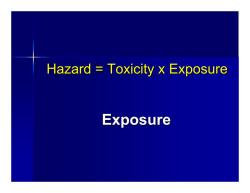
Hazard Toxicity x Exposure Exposure
Hazard = Toxicity x Exposure Hazard = Toxicity x Exposure Exposure Exposure
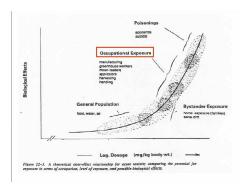
Poisonings accidental suicidal Occupational Exposure manulacturing mixer-loaders 8a9 handling General Population Bystander Exposure food,water,air non08p0Sr82蕃e3) senal dnn . Log.Dosage (mg/kg body wt. Figure 22-3.A theorericni ose-effect relationship for acute tariciry comparing the potential for exposure in ierms of occupation,level of erpasure.and possible biological effects
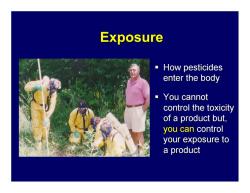
Exposure How pesticides enter the body You cannot control the toxicity of a product but, you can control your exposure to a product
Exposure Exposure How pesticides How pesticides enter the body enter the body You cannot You cannot control the toxicity control the toxicity of a product but, of a product but, you can you can control control your exposure to your exposure to a product a product
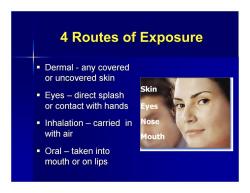
4 Routes of Exposure Dermal any covered or uncovered skin Skin Eyes-direct splash or contact with hands Eyes Inhalation carried in Nose with air Mouth Oral -taken into mouth or on lips
4 Routes of Exposure 4 Routes of Exposure Dermal - any covered any covered or uncovered skin or uncovered skin Eyes – direct splash direct splash or contact with hands or contact with hands Inhalation Inhalation – carried in carried in with air with air Oral – taken into taken into mouth or on lips mouth or on lips Eyes Nose Mouth Skin
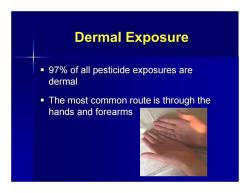
Dermal Exposure 97%of all pesticide exposures are dermal The most common route is through the hands and forearms
Dermal Exposure Dermal Exposure 97% of all pesticide exposures are 97% of all pesticide exposures are dermal The most common route The most common route is through the is through the hands and forearms hands and forearms
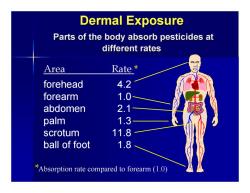
Dermal Exposure Parts of the body absorb pesticides at different rates Area Rate forehead 4.2 forearm 1.0 abdomen 2.1 palm 1.3 scrotum 11.8 ball of foot 1.8 *Absorption rate compared to forearm(1.0)
Dermal Exposure Dermal Exposure Parts of the body absorb pesticides at Parts of the body absorb pesticides at different rates different rates Area Rate * forehead 4.2 forearm 1.0 abdomen 2.1 palm 1.3 scrotum 11.8 ball of foot 1.8 *Absorption rate compared to forearm (1.0)

Dermal Exposure ■ Formulations vary in their ability to be absorbed through the skin. Emulsifiable concentrates are more readily absorbed than other formulations -All formulations can be absorbed in clothing, thereby becoming a path to skin exposure
Dermal Exposure Dermal Exposure Formulations vary in their ability to be absorbed through the skin. Emulsifiable concentrates are more readily absorbed than other formulations All formulations can be All formulations absorbed in clothing, thereby becoming a path to skin exposure
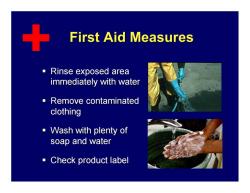
First Aid Measures ■ Rinse exposed area immediately with water Remove contaminated clothing ·Wash with plenty of soap and water Check product label
First Aid Measures First Aid Measures Rinse exposed area Rinse exposed area immediately with water immediately with water Remove contaminated Remove contaminated clothing clothing Wash with plenty of Wash with plenty of soap and water soap and water Check product label Check product label
按次数下载不扣除下载券;
注册用户24小时内重复下载只扣除一次;
顺序:VIP每日次数-->可用次数-->下载券;
- 《植物化学保护》课程教学资源(英文讲稿)Pesticide Hazards and First Aid(PPT).ppt
- 《植物化学保护》课程教学资源(英文讲稿)Pesticide Formulas and Properties.pdf
- 《植物化学保护》课程教学资源(英文讲稿)Pesticide Contamination in Rural Areas.pdf
- 《植物化学保护》课程教学资源(英文讲稿)Pesticide Toxicology(PPT).ppt
- 《植物化学保护》课程教学资源(英文讲稿)Oklahoma Unwanted Pesticide Disposal Program.pdf
- 《植物化学保护》课程教学资源(英文讲稿)No Spray Buffers Lawsuits & Toxicology.pdf
- 《植物化学保护》课程教学资源(英文讲稿)Labels and Pesticide Formulations.pdf
- 《植物化学保护》课程教学资源(英文讲稿)IPMA Primer.pdf
- 《植物化学保护》课程教学资源(英文讲稿)Integrated Pest Management for Urban Landscapes.pdf
- 《植物化学保护》课程教学资源(英文讲稿)Fungicide Use and Aerial Application.pdf
- 《植物化学保护》课程教学资源(英文讲稿)Cross-Border Issues in Environmental Toxicology the US EPA Experience.pdf
- 《植物化学保护》课程教学资源(英文讲稿)Considerations on Foliar Applications and Volume of Pesticides.pdf
- 《植物化学保护》课程教学资源(英文讲稿)Codex Alimentarius Committee on Pesticide Residues.pdf
- 《植物化学保护》课程教学资源(英文讲稿)Aquatic Plant Management.pdf
- 《植物化学保护》课程教学资源(英文讲稿)An Introduction To The Health Effects of Pesticides(PPT).ppt
- 《植物化学保护》课程教学资源(英文讲稿)Alternative Pesticides and New Developments in Pesticide Usage in Orchard Crops.pdf
- 《植物化学保护》课程教学资源(英文讲稿)A New Toxicology Testing Paradigm:Meeting Common Needs.pdf
- 《植物化学保护》课程教学资源(英文讲稿)2009 S&T Water Sampling for Pesticides.pdf
- 华南农业大学:《植物化学保护》课程教学资源(实验指导)实验七 农药残留量分析.doc
- 华南农业大学:《植物化学保护》课程教学资源(实验指导)实验四 杀虫剂药效盆栽试验.doc
- 《植物化学保护》课程教学资源(英文讲稿)Pesticide Laws and Regulations.pdf
- 《植物化学保护》课程教学资源(英文讲稿)Pesticide Registration for Minor Crops and Crop Grouping Effort in Japan.pdf
- 《植物化学保护》课程教学资源(英文讲稿)Pesticide Safety and Toxicity(PPT).ppt
- 《植物化学保护》课程教学资源(英文讲稿)Pesticide Toxicity.pdf
- 《植物化学保护》课程教学资源(英文讲稿)Pesticide Toxicology and Risk Assessment.pdf
- 《植物化学保护》课程教学资源(英文讲稿)Pesticide Waste Challenges.pdf
- 《植物化学保护》课程教学资源(英文讲稿)Pesticides Analysis with the new Agilent 6220 6460 and 6530.pdf
- 《植物化学保护》课程教学资源(英文讲稿)Pesticides.pdf
- 《植物化学保护》课程教学资源(英文讲稿)Plastic Pesticide Container Recycling.pdf
- 《植物化学保护》课程教学资源(英文讲稿)Storage and Disposal.pdf
- 《植物化学保护》课程教学资源(英文讲稿)The Impacts of Adoption of Genetically Engineered Crops on Yields, Pesticide Use and Economic Returns in the USA.pdf
- 《植物化学保护》课程教学资源(英文讲稿)The Influence of Secondary Standards on Pesticide Use.pdf
- 《植物化学保护》课程教学资源(英文讲稿)Toxic Effects of Pesticides.pdf
- 《植物化学保护》课程教学资源(英文讲稿)TOXICOLOGY III Risk Assessment(PPT).ppt
- 《植物化学保护》课程教学资源(英文讲稿)Work and Residential Characteristics Related to Pesticide Exposure among Latino Farmworkers.pdf
- 华南农业大学:《普通昆虫学》课程教学大纲(负责人:王敏).pdf
- 华南农业大学:《普通昆虫学》课程授课教案(讲义,共五篇).docx
- 华南农业大学:《普通昆虫学》课程教学资源(实验指导)实验一 昆虫体躯的基本结构和昆虫的头部.pdf
- 华南农业大学:《普通昆虫学》课程教学资源(实验指导)实验二 昆虫的胸部和腹部.pdf
- 华南农业大学:《普通昆虫学》课程教学资源(实验指导)实验三 昆虫的卵、胚胎发育和胚后发育.pdf
